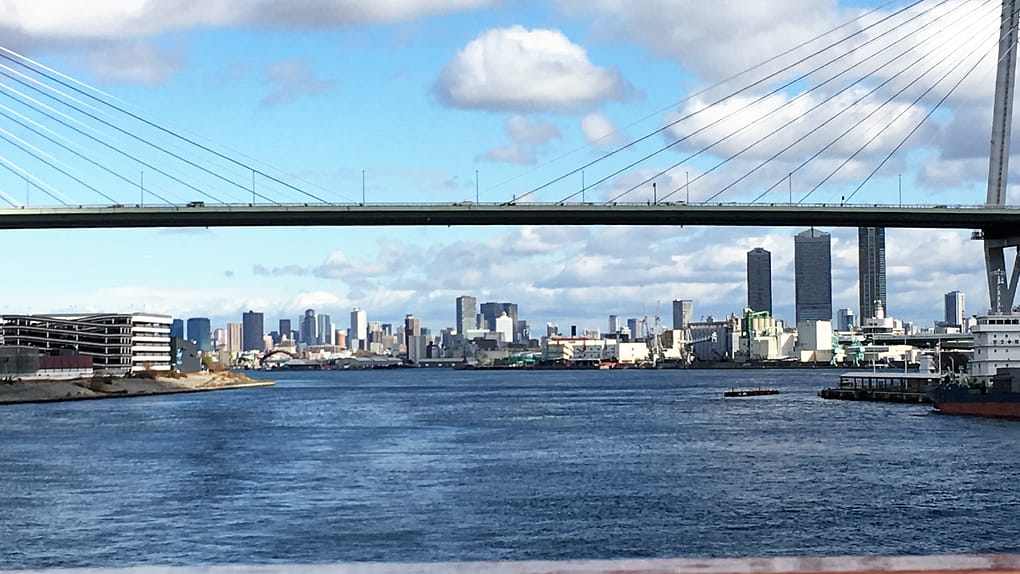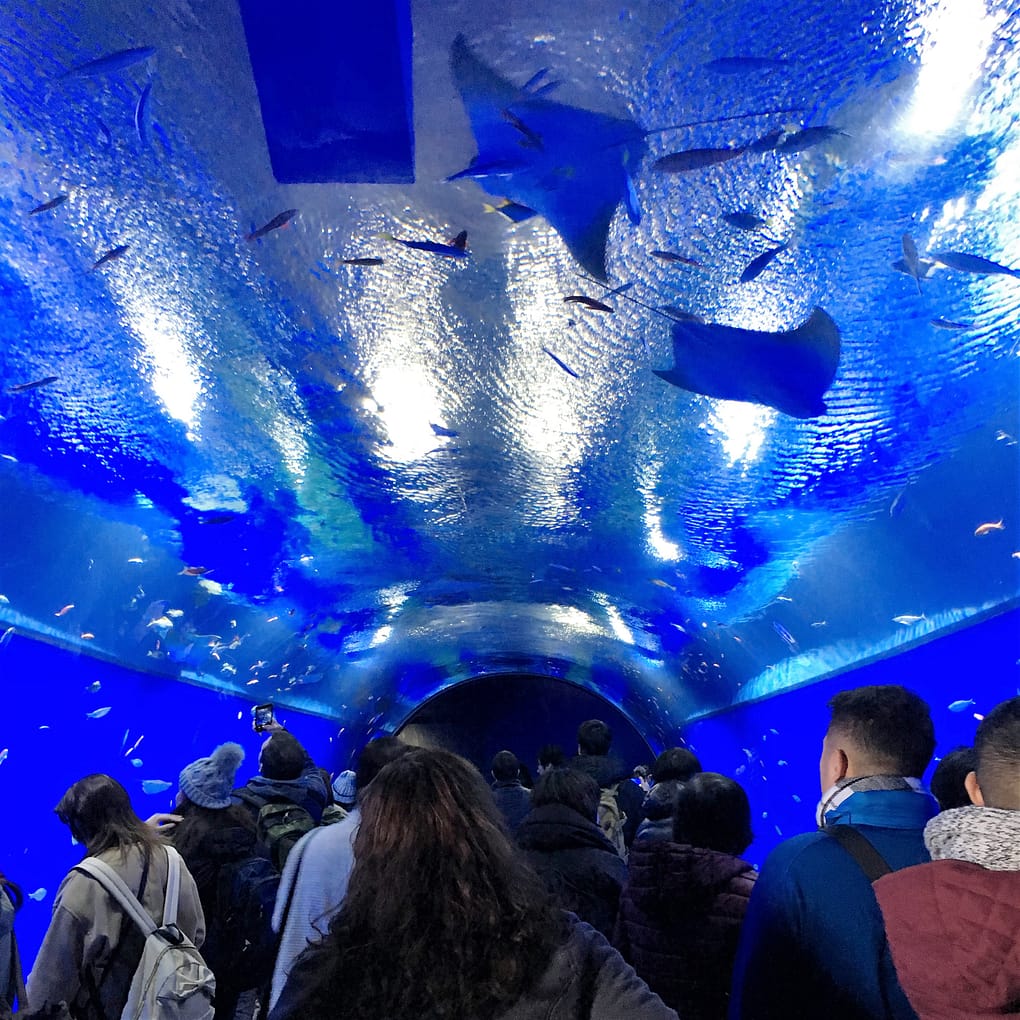All journeys have secret destinations of which the traveler is unaware – Martin Buber
Being stationed in Japan is wonderful! Not only do we have the luxury to experience a new culture, but we also have access to an amazing transportation system. Japan’s railway system gives us easy access to much of Honshu, meaning we can easily head out of town for a long-weekend or block leave. Knowing there are lots of things to do and see while we’re here, Husband and I took advantage of the trains and headed to Osaka during holiday block leave.
At the beginning of the week, we boarded a Shinkansen and rode about 2.5 hours south. After spending two days in Kyoto (read about our adventures HERE and HERE), we hopped a train to Osaka. Spending less than a week total means we didn’t get much time in either city.
Despite the short trip, we made the best out of our two days in Osaka. We ate and drank and saw A LOT. Even though there are still things on our list, Osaka is close enough that we can take another trip down soon. For now, check out some of our favorite things from this trip to Osaka.
Kaiyukan Aquarium
Kaiyukan Aquarium is the world’s largest aquarium. Located on the Aji River, the aquarium is an easy walk from the train station. The area surrounding the aquarium has a lot to offer as well. Legoland Discovery Center, Tempozan Giant Ferris Wheel, and Tempozan Market Place are in the same block, giving visitors plenty to see in the area.
Housing 15 tanks, Kaiyukan aquarium highlights sea life from the Pacific Rim. Entry into the aquarium is 2,300¥ for each adult, but with a coupon from the Osaka Amazing Pass, you can take 100¥ off each ticket.
As with most things in Japan, the aquarium can get crowded. But take heart, if you can squeeze past the throng of people at the entrance, the crowd will dissipate as you move inside. We visited on a Saturday morning, and it was quite enjoyable despite the crowds. One thing I noticed and appreciated about this aquarium is that visitors have multiple options to view each tank. Many of the large tanks are at the center of the space, and the walkway winds down and around. This gave us a chance to see animals we may have missed at the very beginning because of the crowds.
The aquarium is home to lots of marine life, but some of the big-ticket names include whale sharks, stingrays, sea lions, dolphins, and otters. There’s a small gift shop inside the aquarium area if you’d like a souvenir. As expected, it gets crowded inside. There’s a larger, and often overlooked, shop downstairs.
Shitenno-ji Temple
Shitenno-ji Temple made our list because of its unique history. Founded in 593, it is largely thought to be the first Buddhist temple in Japan. It also tops the list as the oldest officially administered temple in the country.
The property houses many buildings typically found at Buddhist temples. Many of these have been rebuilt and restored throughout the temple’s long history. Visitors can see the main pavilion, a lecture hall, and three entrance gates.
One of the big draws for the complex is the five-story pagoda. For 300¥ (or free with the Amazing Pass), visitors can climb the narrow staircase up to the top of the pagoda. Except for the pagoda, the temple complex is free to visit.
If you’re traveling toward the end of the month, make sure to mark your calendar for Shitenno-ji’s flea market. On the 21st and 22nd of each month, vendors come to sell their wares from 8:00 am – 4:00 pm. During our visit, we did notice a few permanent shops outside the gates selling pottery and snacks. The area surrounding Shitenno-ji is bustling and also worth exploring.
Nambayasaka Shrine
Nambayasaka Shrine was a last-minute addition to our Osaka to-do list. We were able to squeeze it in right after Shitenno-ji. The two sites are about a 30-minute walk from each other.
Using Google maps to walk to the shrine was easy. As we got closer to Nambayasaka, we found an entrance that was close, but not exactly where Google was leading us. We almost said, “close enough” and went it, but decided against it. Instead, we kept to Google’s route, and I’m so glad we did. It is through this torii that you get the full effect of the shrine.
As we turned the corner into the complex, Husband, who didn’t know what to expect, was very surprised. Directly in front of us, staring with large eyes and open mouth, was a huge lion head. Meant to function as a stage, the structure measures around 12 m tall and 7 m deep. That’s nearly 40 ft tall and 23 ft deep for all my USA friends.
The lion’s mouth is believed to swallow evil spirits. It’s a popular visit for students during exam time and for businessmen at the start or end of the fiscal year. For most of our time there, Husband and I were the only visitors. I guess no one had a test coming up. We highly recommend this unique shrine if you have time for a quick stop.
Santa Maria Cruise on Osaka Bay
Who wouldn’t want to take a trip around the Osaka bay in a model of Columbus’ famous ship – for free? The Santa Maria Cruise is a great family-friendly activity. During the day, the boat takes a 50-minute tour around the bay. There are snack-type food and drinks available for purchase on board. The best part – you can wander the outside decks and take in a unique view of Osaka. Throughout the trip, a recording points out interesting landmarks, but everything is in Japanese.
Although it was chilly outside on the day of our visit, Husband and I were able to wander on the deck in only hoodies. The temperature was very temperate on the water. There’s also a twilight cruise option that lasts a little longer. Because we visited Osaka around the New Year holiday, the twilight tour wasn’t available.
If you’ve purchased the Amazing Pass, you can disregard the 1,600¥ fee and board for free! You don’t even need to stop at the window for a ticket. Just head down to the dock and wait in line. For an extra 500¥, you can sit in “first class”, which includes a free drink.
We found the visit pleasant although with no great thrills. This may be a fun option with younger kiddos. The boarding dock is in the same area as Kaiyukan Aquarium, making it easy to go from one to the other. However, if your schedule is tight, I would recommend skipping this activity.
Dotonbori Street
Dotonbori street is one of the most popular stops for tourists in Osaka. Osaka, especially Dotombori Street, is often regarded as the food capital of Japan. The street dates all the way back to 1612. There are so many things to try, so plan to spend some time in this area.
Our two days in Osaka was both a weekend and right around New Years, so many people were off of work. The Dotonbori area was very crowded, but there’s so much to look at, I didn’t mind all the people.
The main street runs parallel to the Dotonbori river (hence its name). There are a lot of companies along the waterway that offer cruises to showcase the 16 bridges that cross the river. Imagine our surprise when our “pirate cruise” turned out to be about bridges! I don’t think this activity would have made our radar if it wasn’t free with the Amazing Pass. Despite that, it’s a fun and different way to see Dotonbori. Each of the bridges is unique, and although our “cruise director” didn’t speak English, our handout was quite informative. My favorite was probably the spatula bridge. This was designed to celebrate the chef that created okonomiyaki, a staple now found throughout Japan.
Side note: If you’re a fan of Anthony Bourdain, as we are, make sure to check out No Reservations season 2 episode 7. He visits Osaka and spends some time in Dotonbori street.
Shinsaibashi Street
If Dontombori street was all about food, Shinsaibashi street is all about shopping. The shopping area runs for over 500 meters and contains more than 150 stores. Shinsaibashi is a covered street, so it’s easy to enjoy no matter the weather. As expected, this area is crowded. There are as many as 60,000 daily visitors, with the numbers easily doubling on the weekends.
Visitors will find a selection of known international brands like H&M, Lush, and The Body Shop, as well as Japanese brands. There are a few places to grab a bite to eat right at the beginning of the street. For us, Shinsaibashi was towards the end of the day and we walked through en route to somewhere else. It was a fun stroll, but there wasn’t anything we needed that we couldn’t find back home in Tokyo.
Because we traveled between Christmas and the New Year, we lived a valuable lesson first hand. Christmas is not a national holiday in Japan. If it falls on a weekday, school is still in session and people still work. The New Year, however, is a big deal. Many businesses and tourist destinations close starting on December 28 or 29, and you won’t see many reopen until well into the first week of the new year. Many of the places we wanted to visit were closed for the holiday.
Although we didn’t get to cross everything off our list, we did visit a fair number of things in 2 days. In a way, I really like quick visits. Not being able to see everything only whets our appetite for more and entices us to come back.
Have you visited Osaka? Leave a comment and let me know your favorite spot!























